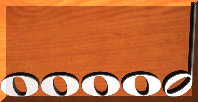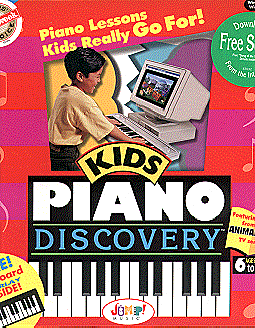|
|||
e have previously reviewed Jump! Music's Piano Discovery System in both Version 2 and Version 3. Each of these presents an attractive and pedagogically sound piano learning environment directed at older children and adults. Now Jump has put together a special version of the Piano Discovery System, Kids Piano Discovery, just for younger children. It preserves the advantages of the Piano Discovery System, but makes it more friendly to little kids. Kids Piano Discovery is designed for ages 6-12. However, I did use this program without difficulty with some 4 and 5 year olds by sitting with them while they were working. We examined only Year 1 in this review, since Kids Piano Discovery is only available in Year 1. After year 1, students (with some reviewing) can move on to the regular version of the Piano Discovery System.
|
|||
|
The main screen of Kids Piano Discovery uses the same theme park metaphor as the Piano Discovery System. The basic course of study in Kids Piano Discovery is the same as its older brothers. Just as in the Piano Discovery System, you'll find Performance Hall, Arcade Games and Practice Bungalow to help learn piano repertoire. Kids Piano Discovery employs the same practice philosophies and techniques (including use of the metronome, slow practice progressing up to top speed, hands separate practice). For more details on the course itself, see our reviews of the Piano Discovery System, both Version 2 and Version 3. In Kids Piano Discovery, kids learn about correct posture and hand position, how to find notes on the piano, the concepts of sharps/flats, and how to play the piano with both hands. There is a very good description of the treble and bass clefs and a wonderful job was done explaining the lines and spaces of the clefs. Use of the metronome is introduced early on and emphasized by having one of the narrators count aloud an entire measure with the metronome before the student starts an exercise or a piece of music. We really appreciated this aspect, as it makes sure that students understand the concept of counting at least 2 measures in tempo before they begin to work on a piece of repertoire. Rhythm and note durations are well explained and the follow-up practice after the initial explanation also very well done. The narrators in PDS are replaced in Kids PDS by two new ones named Paul and Diane. The text of their personable, fun, and pedagogically sound narration reflects a great deal of thought about how to provide positive reinforcement for young children. Kids Piano Discovery also borrows songs from the cartoon show, Animaniacs to make the learning environment both familiar and fun for kids. When a student does a specific part of the lesson correctly, like finding all the notes C on the keyboard, a wonderful picture appears on the screen along with a voice saying something fun like "Groovy - you did this well." The kids in my studio got a giggle from the Animaniacs songs. If a student skips over playing something that they really should not have skipped, a little reminder is heard, letting the kids know that, uh-oh, they shouldn't have skipped that part of the exercise. If that does not work, Paul and Diane very gently but firmly let the student know that they really need to go back to do that exercise again. The repertoire for the lessons and the extra pieces of music in the Practice Bungalow include some of the same pieces found in the other Piano Discovery programs. However, a lot of pieces of music from Animaniacs have been added, as well as tunes that are just more kid friendly and familiar. Repertoire choices included the Animaniacs Theme Song, Yakko's Universe, Jingle Bells, Happy Birthday, Heart and Soul, William Tell Overture, Yankee Doodle, Bringin' in the Sheaves, and many more. All the young students in our studio who worked with this system and the other Piano Discovery System versions preferred the piano repertoire in Kids Piano Discovery over that of the other versions. After each piece of music is learned and performed in the recital hall, the student can print up a certificate of achievement for that specific song, and use some of the stickers provided with the program to put on the certificate. A few of my students were busy collecting these certificates and it was a matter of great pride to them to have many of the certificates with the cool stickers on them to show people. It was also a lot of fun to hear the narrators give their commentary on how the performance went in the Performance Hall; if more practice work was needed, the narration ever so gently and in a positive tone, urged the students to go back and work on the piece of music some more. The Arcade games in the Level 1 were a lot of fun. The Shooting Gallery is again present, but in Kids Piano Discovery, the kids can pick from either shooting ducks or balloons. My students really enjoyed these games. Without them really being aware of it, they were learning and developing strong sight reading skills. Another interesting game is found in the Rhythm Arcade. In this game, the student guides a space ship to shoot some paint on the notes when they play the rhythm correctly. No specific note reading or playing is involved in this game, it focuses exclusively on the rhythmical aspects. The only miscue that we found in Kids PDS was the provision of stickers to be placed on the keys, giving the names of the notes and/or finger numbers. Too many beginning students get into their heads that finger 1 means middle C, that finger 2 means middle D, etc. They end up getting locked into position playing rather than learning to identify the specific notes easily and smoothly. We found that placing the stickers on the notes did more harm than good. After a few weeks, we stopped using them because they were impeding the note reading progress of the students. Although the stickers made it easier to play the songs, the kids were not really learning to read the music. If you get Kids Piano Discovery for your children or students, we suggest you hide or throw away the note stickers (not the certificate stickers) or at least use them only for a very short period of time. Kids Piano Discovery is a wonderful piano learning program for young children. It retains the approach and pedagogical soundness of the other Piano Discovery System versions that we have examined, but presents the information in a manner which is more familiar and fun for young children. Kids Piano Discovery, Version 1.1. List price $49.99. Jump Software, 201 San Antonio Circle, Suite 172, Mountain View, CA 94040 Phone: 1-800-289-5867; 1-415-917-7460. Requirements: 486 or higher multimedia PC, 8 Mb RAM (minimum), 2X CD-ROM drive or better, Windows 3.1/95, 100% Sound blaster or compatible sound card. Recommended: Standard MIDI piano and cable. Also available for Macintosh without the keyboard overlay. |
||
|
Page
created: 1/4/98 Last updated: 02/09/24 |



 Installation and configuration of Kids
Piano Discovery went without incident on a Windows 3.1 system. The program CD-ROM has
300 lessons. If you don't have a MIDI keyboard, Kids Piano Discovery provides a
very helpful computer keyboard overlay that sits on top of the PC keyboard. This is a
great idea for those students just starting piano and is easy for parents, since no
connection to the computer CPU is necessary. However, Jump recommends that you eventually
get a MIDI keyboard that can connect to the computer sound card.
Installation and configuration of Kids
Piano Discovery went without incident on a Windows 3.1 system. The program CD-ROM has
300 lessons. If you don't have a MIDI keyboard, Kids Piano Discovery provides a
very helpful computer keyboard overlay that sits on top of the PC keyboard. This is a
great idea for those students just starting piano and is easy for parents, since no
connection to the computer CPU is necessary. However, Jump recommends that you eventually
get a MIDI keyboard that can connect to the computer sound card.